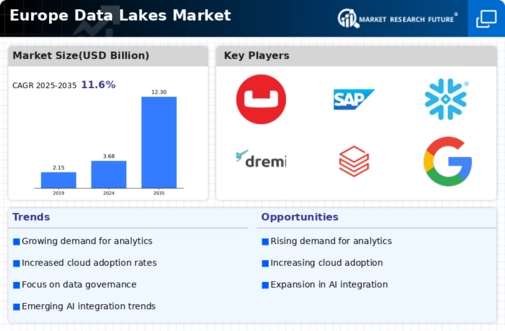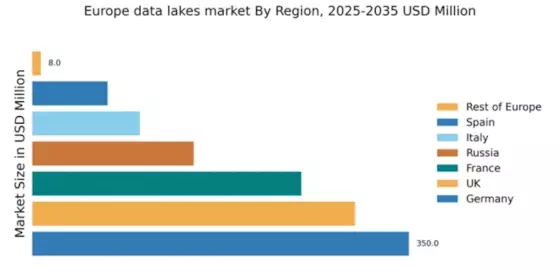Germany : Strong Infrastructure and Innovation Hub
Germany holds a commanding market share of 350.0, representing approximately 35% of the European data lakes market. Key growth drivers include robust industrialization, a strong focus on digital transformation, and government initiatives promoting data-driven innovation. The demand for data lakes is fueled by sectors such as automotive, finance, and healthcare, which are increasingly adopting data analytics for operational efficiency. Regulatory frameworks like the GDPR also encourage businesses to invest in secure data management solutions.
UK : Innovation and Investment Drive Market
The UK data lakes market is valued at 300.0, accounting for about 30% of the European market. Growth is driven by a surge in cloud adoption, particularly among SMEs, and a strong emphasis on data analytics across various sectors. The UK government supports this trend through initiatives like the Digital Strategy, which aims to enhance the country's digital capabilities. The demand for data lakes is particularly high in finance, retail, and healthcare, where data-driven decision-making is critical.
France : Strong Demand in Diverse Sectors
France's data lakes market is valued at 250.0, representing 25% of the European market. Key growth drivers include the increasing need for data integration and analytics in sectors like telecommunications, retail, and public services. The French government has launched initiatives to promote digital innovation, including the France 2030 plan, which aims to boost the digital economy. The demand for data lakes is also supported by a growing startup ecosystem focused on data solutions.
Russia : Growth Amidst Regulatory Challenges
Russia's data lakes market is valued at 150.0, making up about 15% of the European market. Growth is driven by the increasing adoption of big data technologies in sectors like energy, finance, and telecommunications. However, regulatory challenges, including data localization laws, impact market dynamics. The Russian government is actively promoting digital transformation through initiatives like the National Program for Digital Economy, which aims to enhance data infrastructure and analytics capabilities.
Italy : Focus on Digital Transformation
Italy's data lakes market is valued at 100.0, representing 10% of the European market. Key growth drivers include the push for digital transformation across industries such as manufacturing, retail, and finance. The Italian government has introduced initiatives like the National Plan for Industry 4.0 to foster innovation and data utilization. Demand for data lakes is growing as businesses seek to leverage data for competitive advantage and operational efficiency.
Spain : Investment in Data Infrastructure
Spain's data lakes market is valued at 70.0, accounting for 7% of the European market. Growth is driven by increasing investments in data infrastructure and analytics, particularly in sectors like tourism, finance, and healthcare. The Spanish government supports digital initiatives through programs aimed at enhancing data capabilities. The demand for data lakes is rising as organizations seek to harness data for improved decision-making and customer insights.
Rest of Europe : Emerging Markets and Innovations
The Rest of Europe data lakes market is valued at 8.0, representing a small but growing segment of the overall market. Key growth drivers include the increasing adoption of cloud technologies and data analytics across various sectors. Emerging markets in Eastern Europe are beginning to invest in data infrastructure, supported by EU funding initiatives. The competitive landscape is diverse, with local players and international firms vying for market share in this evolving space.


















Leave a Comment